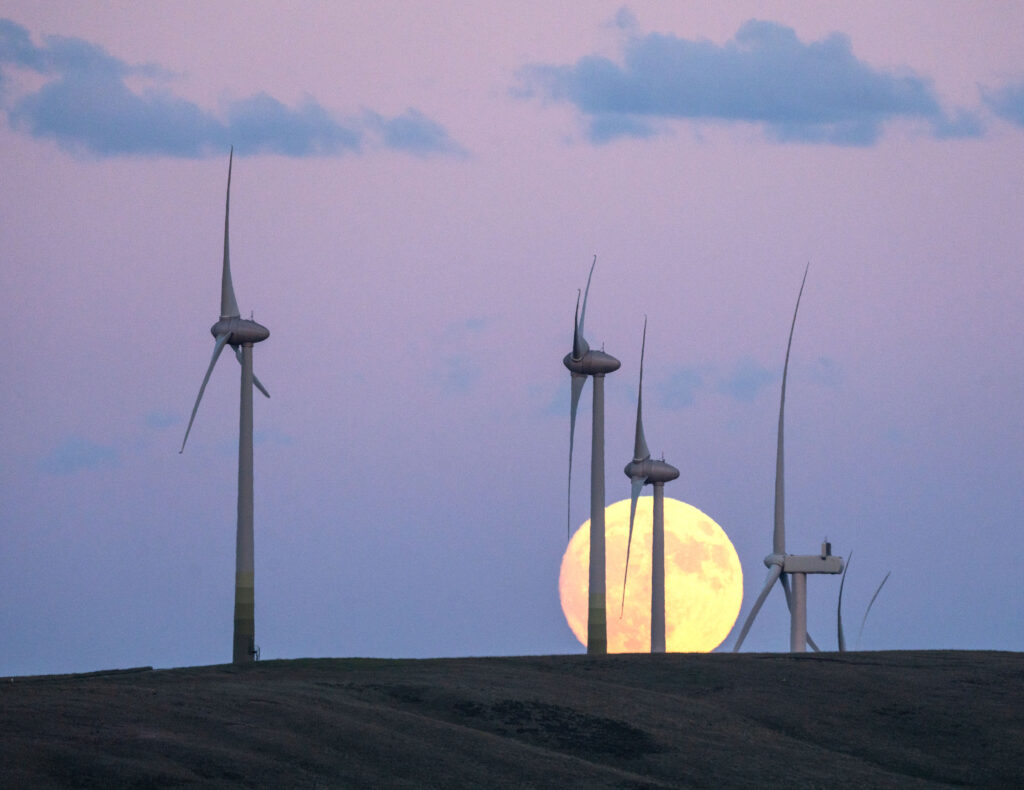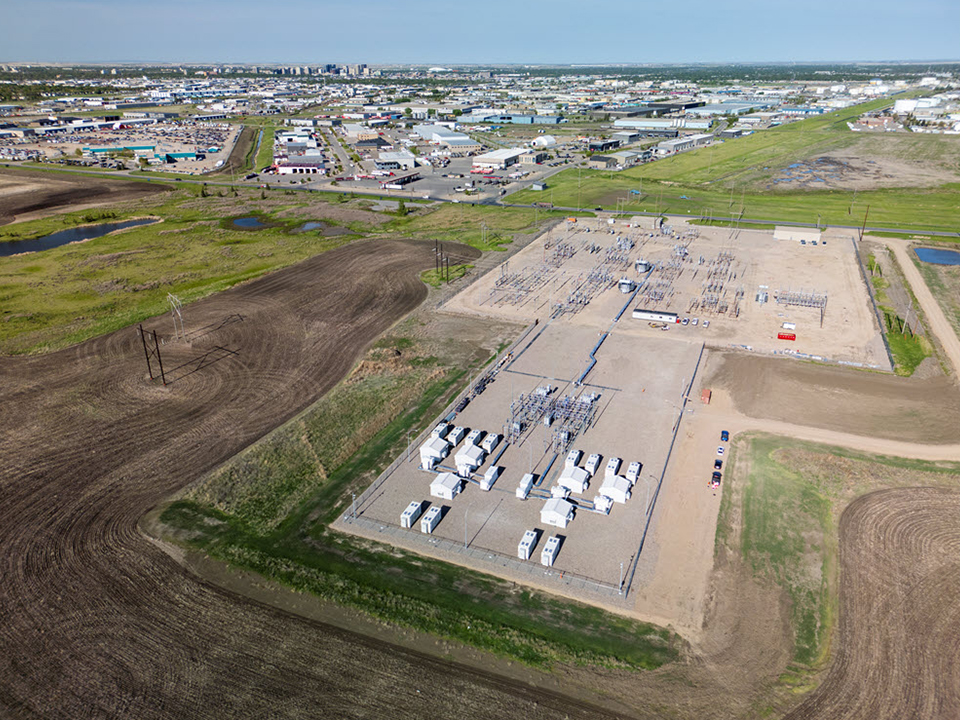Brian Zinchuk is editor and owner of Pipeline Online

Alberta wind turbines. Photo by Clive Schaupmeyer
On July 6, the Pembina Institute published a paper by executive director Chris Severson-Baker on July 6, headlined, “For the first time in more than 150 years, Alberta’s electricity is coal free.”
And on July 8, the province went into yet another “grid alert,” as its ever-increasing reliance on renewables yet again failed to keep up to demand.
The AESO declared a Grid Alert at 8:25 p.m. on Monday, July 8, 2024. Find information on Grid Alerts here https://t.co/OX5JR5UKCI pic.twitter.com/pGagofey1C
— AESO (@theAESO) July 9, 2024
Alberta’s electrical grid is continuing to show a consistent pattern: when it’s really hot, or really cold, the wind hardly blows at all. And when the sun goes down and solar power falls off the grid, the stability of the grid is often threatened, resulting in “grid alerts.”
That’s when the Alberta Electric System Operator warns the public that unless they reduce electrical consumption immediately, there’s a threat of rolling blackouts.
Things got pretty dicey back in January, when it was 30 below. And they got that way again on July 8, when it was 30 above through a good chunk of the day. The difference is, no one’s going to freeze to death in July.
Throughout the day of Monday, July 8, Alberta’s wind power generation was minimal, at best. And while the sun was shining throughout the day, the Alberta electrical grid did okay.
And then the sun went down.
And since it was a hot day, with heat warnings covering the entire province (as well as large swathes of BC and northern Saskatchewan), the air conditioning was cranked up.
Combined with this, the province’s last coal-fired power plant went offline, for good, just a few weeks earlier, as noted by the Pembina Institute. It’s being converted to natural gas. But addition late last year of 900 megawatts of combined cycle natural gas at Cascade 1 and 2 should have been enough to compensate for coal’s loss, at least until it’s been repowered by natural gas, right?
Apparently not.
- 0085 Turnbull snow removal call office0085 Turnbull snow removal call office
- 0110 SaskEnergy SEI_Network_Members_Burn_Brighter0110 SaskEnergy SEI_Network_Members_Burn_Brighter
- 0109 SaskPower SASPO_2817_PLT_Recruitment_DIVERSITY0109 SaskPower SASPO_2817_PLT_Recruitment_DIVERSITY
- 0105 SaskEnergy Commitment to Safety0105 SaskEnergy Commitment to Safety
- 0102 Lori Carr Coal Extended0102 Lori Carr Coal Extended
- 0100 Turnbull Project Manager0100 Turnbull Project Manager
- 0099 Mryglod Steel 1080p0099 Mryglod Steel 1080p
- 0097 Eagle Sky Ventures LTD0097 Eagle Sky Ventures LTD
- 0095 Fast Trucking nearly 70 years good at it0095 Fast Trucking nearly 70 years good at it
- 0092 Turnbull projects big and small0092 Turnbull projects big and small
- 0046 City of Estevan This is Estevan Teaser0046 City of Estevan This is Estevan Teaser
- 0077 Caprice Resources Stand Up For Free Speech0077 Caprice Resources Stand Up For Free Speech
- 0061 SIMSA 2024 For Sask Buy Sask0061 SIMSA 2024 For Sask Buy Sask
- 0051 JML Hiring Pumpjack assembly0051 JML Hiring Pumpjack assembly
- 0049 Scotsburn Dental soft guitar0049 Scotsburn Dental soft guitar
- 0041 DEEP Since 2018 now we are going to build0041 DEEP Since 2018 now we are going to build
- 0032 IWS Summer hiring rock trailer music
- 0022 Grimes winter hiring
- 0021 OSY Rentals S8 Promo
- 0018 IWS Hiring Royal Summer
- 0013 Panther Drilling PO ad 03 top drive rigs
- 0002 gilliss casing services0002 gilliss casing services
- 9002 Pipeline Online 30 sec EBEX9002 Pipeline Online 30 sec EBEX
- 9001
The Alberta Electric System Operator declared a “Grid alert” at 8:25 p.m. The alert was lifted at 9:34 p.m.,
Just a few minutes after the grid alert was declared, here was the state of the Alberta grid, as recorded from AESO data by X account @ReliableAB. That account posts hourly logs of the Alberta grid.
At this moment 89.8% of Alberta's electricity is being produced by fossil fuels. Wind is at 2.9% of capacity and producing 1.3% of total generation, while solar is at 8.2% of capacity and producing 1.27% of total generation. At the same time we are importing 420 MW or 4% pic.twitter.com/vlU2Ec0dj0
— Reliable AB Energy (@ReliableAB) July 9, 2024
At that moment, solar power was falling off, down to 135 megawatts. It was 1,400 out of 1,650 megawatts earlier in the afternoon. Solar was providing a good chunk of power during the daylight hours, but its renewable counterpart, wind, was not. Wind output, which has a theoretical capacity of 4,478 megawatts, hovered around 100-150 megawatts through most of the day. And at this moment, it was outputting just 139 megawatts, or 2.9 per cent of nameplate capacity.
Alberta was importing power from all sides, totalling 420 megawatts.
Hydro capacity was cranked up as they literally opened up the gates. This has been common practice when Alberta’s grid is under threat. The Brazeau Dam, Alberta’s largest, had generally been putting out around 70 megawatts through most of the day, was cranked up to around three times that value generating around 200 megawatts throughout most of the evening until 8:48 p.m., when it started throttling back. This is one of the benefits of hydro power, the ability to ramp up and down quickly in response to grid demand or lack thereof.
Most of Alberta’s gas-fired fleet, be they simple cycle, combined cycle or gas-fired steam, were cranked up to capacity.
- 0085 Turnbull snow removal call office0085 Turnbull snow removal call office
- 0110 SaskEnergy SEI_Network_Members_Burn_Brighter0110 SaskEnergy SEI_Network_Members_Burn_Brighter
- 0109 SaskPower SASPO_2817_PLT_Recruitment_DIVERSITY0109 SaskPower SASPO_2817_PLT_Recruitment_DIVERSITY
- 0105 SaskEnergy Commitment to Safety0105 SaskEnergy Commitment to Safety
- 0102 Lori Carr Coal Extended0102 Lori Carr Coal Extended
- 0100 Turnbull Project Manager0100 Turnbull Project Manager
- 0099 Mryglod Steel 1080p0099 Mryglod Steel 1080p
- 0097 Eagle Sky Ventures LTD0097 Eagle Sky Ventures LTD
- 0095 Fast Trucking nearly 70 years good at it0095 Fast Trucking nearly 70 years good at it
- 0092 Turnbull projects big and small0092 Turnbull projects big and small
- 0046 City of Estevan This is Estevan Teaser0046 City of Estevan This is Estevan Teaser
- 0077 Caprice Resources Stand Up For Free Speech0077 Caprice Resources Stand Up For Free Speech
- 0061 SIMSA 2024 For Sask Buy Sask0061 SIMSA 2024 For Sask Buy Sask
- 0051 JML Hiring Pumpjack assembly0051 JML Hiring Pumpjack assembly
- 0049 Scotsburn Dental soft guitar0049 Scotsburn Dental soft guitar
- 0041 DEEP Since 2018 now we are going to build0041 DEEP Since 2018 now we are going to build
- 0032 IWS Summer hiring rock trailer music
- 0022 Grimes winter hiring
- 0021 OSY Rentals S8 Promo
- 0018 IWS Hiring Royal Summer
- 0013 Panther Drilling PO ad 03 top drive rigs
- 0002 gilliss casing services0002 gilliss casing services
- 9002 Pipeline Online 30 sec EBEX9002 Pipeline Online 30 sec EBEX
- 9001
Three of Alberta’s 10 grid-scale batteries were called into play during the alert, the three newest ones – eReserve7, 8 and 9. But several of those batteries could be down for maintenance. eReserve3, for instance, hasn’t lit a lightbulb since March, according to Dispatcho.app, which also logs AESO data. The same goes for eReserve5. eReserve6 hasn’t contributed power to the grid since late February.

SaskPower’s first utility-scale battery is located on the east side of the city. SaskPower
This is significant, as SaskPower just commissioned its first Battery Energy Storage System (BESS) on June 28. That 20 megawatt system cost $36 million, after its initial announcement said it would cost $26 million. There is a significant difference, however. All of Alberta’s grid-scale batteries to date have been Tesla Megapack models, while SaskPower’s is made by Saft. Maybe they’re be a difference in performance.
As for that Pembina piece, it said, “Renewable energy is already the most cost-effective form of new electricity generation, and costs continue to drop. But we still need to bring online more wind and solar, along with storage. Historically a leader in renewable energy, Alberta’s seven-month renewables moratorium, new restrictions unique to renewables, and a market restructuring have chilled project development. Restoring certainty should be a priority for the government. Alberta also already has enough existing and planned gas on its grid to meet its electricity needs.”
Let’s address that: The storage already available on the grid was not fully called upon, despite the grid alert. As mentioned above, several batteries haven’t supplied a watt of power for months, and they weren’t supplying it on July 8. More wind and solar would not have made a difference on July 8. Alberta’s already doubled both in recent years, and it still wasn’t enough, by a long shot. When the sun went down, more solar wouldn’t matter. And wind was less than three per cent output. So more of it won’t make much difference.
As for “Alberta already has enough existing and planned gas on its grid to meet its electricity needs,” clearly this is not the case. If it did, they wouldn’t have had to ramp up imports from all their neighbours while cranking open its largest dam. All that, and it still wasn’t enough.
“Most of Alberta will see the hottest temperatures, up to 37 degrees Celsius, on Tuesday and Wednesday,” Environment and Climate Change Canada said in its heat warning.
Imagine that. Expect more grid alerts to come.
Brian Zinchuk is editor and owner of Pipeline Online, Saskatchewan’s Energy News, and occasional contributor to the Frontier Centre for Public Policy. He can be reached at brian.zinchuk@pipelineonline.ca
Update:
The following morning, wind power was producing 26 megawatts out of an installed based of 4748 megawatts at 8:49 a.m. That’s one half of one per cent capacity. Only 12 of 45 wind farms were producing any power to the grid at all at that moment.
- 0085 Turnbull snow removal call office0085 Turnbull snow removal call office
- 0110 SaskEnergy SEI_Network_Members_Burn_Brighter0110 SaskEnergy SEI_Network_Members_Burn_Brighter
- 0109 SaskPower SASPO_2817_PLT_Recruitment_DIVERSITY0109 SaskPower SASPO_2817_PLT_Recruitment_DIVERSITY
- 0105 SaskEnergy Commitment to Safety0105 SaskEnergy Commitment to Safety
- 0102 Lori Carr Coal Extended0102 Lori Carr Coal Extended
- 0100 Turnbull Project Manager0100 Turnbull Project Manager
- 0099 Mryglod Steel 1080p0099 Mryglod Steel 1080p
- 0097 Eagle Sky Ventures LTD0097 Eagle Sky Ventures LTD
- 0095 Fast Trucking nearly 70 years good at it0095 Fast Trucking nearly 70 years good at it
- 0092 Turnbull projects big and small0092 Turnbull projects big and small
- 0046 City of Estevan This is Estevan Teaser0046 City of Estevan This is Estevan Teaser
- 0077 Caprice Resources Stand Up For Free Speech0077 Caprice Resources Stand Up For Free Speech
- 0061 SIMSA 2024 For Sask Buy Sask0061 SIMSA 2024 For Sask Buy Sask
- 0051 JML Hiring Pumpjack assembly0051 JML Hiring Pumpjack assembly
- 0049 Scotsburn Dental soft guitar0049 Scotsburn Dental soft guitar
- 0041 DEEP Since 2018 now we are going to build0041 DEEP Since 2018 now we are going to build
- 0032 IWS Summer hiring rock trailer music
- 0022 Grimes winter hiring
- 0021 OSY Rentals S8 Promo
- 0018 IWS Hiring Royal Summer
- 0013 Panther Drilling PO ad 03 top drive rigs
- 0002 gilliss casing services0002 gilliss casing services
- 9002 Pipeline Online 30 sec EBEX9002 Pipeline Online 30 sec EBEX
- 9001
